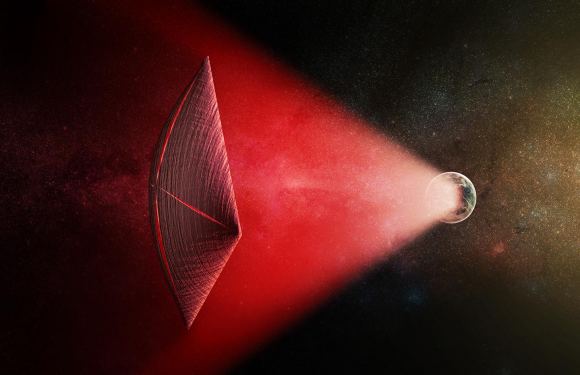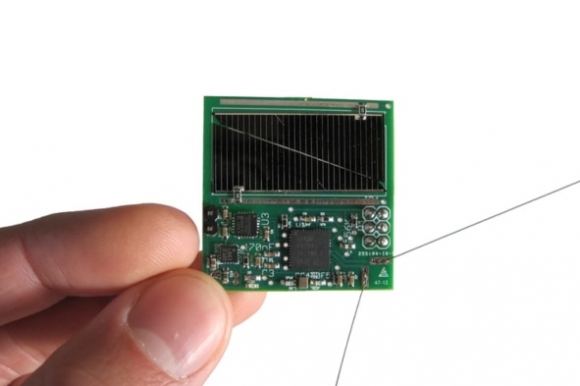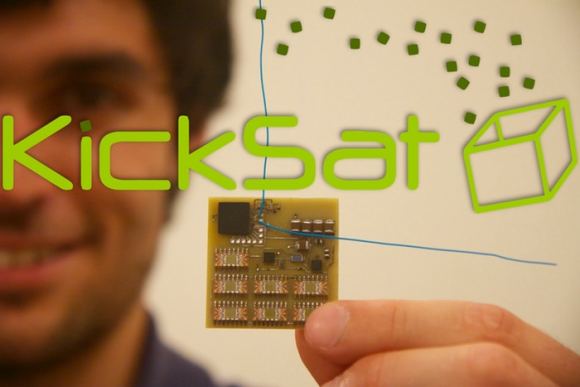In 2015, Russian billionaire Yuri Milner established Breakthrough Initiatives, a non-profit organization dedicated to enhancing the search for extraterrestrial intelligence (SETI). In April of the following year, he and the organization be founded announced the creation of Breakthrough Starshot, a program to create a lightsail-driven "wafercraft" that would make the journey to the nearest star system - Alpha Centauri - within our lifetime.
This past June, the organization took a major step towards achieving this goal. After hitching a ride on some satellites being deployed to Low Earth Orbit (LEO), Breakthrough conducted a successful test flight of its first spacecraft. Known as "Sprites", these are not only the smallest spacecraft ever launched, but prototypes for the eventual wafercraft Starshot hopes to send to Alpha Centauri.
The concept for a wafercraft is simple. By leveraging recent developments in computing and miniaturization, spacecraft that are the size of a credit card could be created. These would be capable of carrying all the necessary sensors, microprocessors and microthrusters, but would be so small and light that it would take much less energy to accelerate them to relativistic speeds - in the case of Starshot, up to 20% the speed of light.

Artist's illustration of a light-sail powered by a laser beam (red) generated on Earth's surface. Credit: M. Weiss/CfA
As Pete Worden - Breakthrough Starshot's executive director and the former director of NASA's Ames Research Center - said in an interview with Scientific American:
"This is a very early version of what we would send to interstellar distances. In addition, this is another clear demonstration that it is possible for countries to work together to do great things in space. These are European spacecraft with U.S. nanosatellite payloads launching on an Indian booster—you can't get much more international than that."
Professor Abraham Loeb also has some choice words to mark this historic occasion. In addition to being the Frank B. Baird Jr. Professor of Science, the Chair of the Astronomy Department and the Director of the Institute for Theory and Computation at Harvard University, Prof. Loeb is also the chairman of the Breakthrough Starshot Advisory Committee. As he told Universe Today via email:
"The launch of the Sprite satellites marks the first demonstration that miniaturized electronics on small chips can be launched without damage, survive the harsh environment of space and communicate successfully with earth. The Starshot Initiative aims to launch similar chips attached to a lightweight sail that it being pushed by a laser beam to a fifth of the speed of light, so that its camera, communication and navigation devices (whose total weight is of order a gram) will reach the nearest planet outside the solar System within our generation."

A prototype Sprite nanosatellite, showing its solar panel, microprocessors, sensors and transmitters. Credit: Zac Manchester
The craft were deployed on June 23rd, piggybacking on two satellites belonging to the multinational technology corporation OHB System AG. Much like the StarChips that Starshot is proposing, the Sprites represent a major step in the evolution of miniature spacecraft that can do the job of larger robotic explorers. They measure just 3.5 by 3.5 cm (1.378 x 1.378 inches) and weight only four grams (0.14 ounces), but still manage to pack solar panels, computers, sensors and radios into their tiny frames.
The Sprite were originally conceived by Zac Manchester, a postdoctorate researcher and aerospace engineer at Cornell University. Back in 2011, he launched a Kickstarter campaign (called "KickSat") to raise funds to develop the concept, which was his way of bringing down the associated costs of spaceflight. The campaign was a huge success, with Manchester raising a total of $74,586 of his original goal of $30,000.
Now a member of Breakthrough Starshot (where he is in charge of Wafer design and optimization), Manchester oversaw the construction of the Sprites from the Sibley School of Mechanical and Aerospace Engineering at Cornell. As Professor Loeb explained:
"The Sprites project is led by Zac Manchester, a Harvard postdoc who started working on this during his PhD at Cornell. Sprites are chip-size satellites powered by sunlight, intended to be released in space to demonstrate a new technology of lightweight (gram-scale) spacecrafts that can communicated with Earth."

Zac Manchester holding a prototype KickSat. Credit: Zac Manchester/kickstarer
The purpose of this mission was to test how well the Sprites' electronics systems and radio communications performed in orbit. Upon deployment, the Sprites remained attached to these satellites (known as "Max Valier" and "Venta") and began transmitting. Communications were then received from ground stations, which demonstrated that the Sprites' novel radio communication architecture performed exactly as it was designed to.
With this test complete, Starshot now has confirmation that a waferocraft is capable of operating in space and communicating with ground-based controllers. In the coming months and years, the many scientists and engineers that are behind this program will no doubt seek to test other essential systems (such as the craft's microthrusters and imagers) while also working on the various engineering concerns that an instellar mission would entail.
In the meantime, the Sprites are still transmitting and are in radio contact with ground stations located in California and New York (as well as radio enthusiasts around the world). For those looking to listen in on their communications, Prof. Loeb was kind enough to let us know what frequency they are transmitting on.
"The radio frequency at which the Sprites that were just launched operate is 437.24 MHz, corresponding to a wavelength of roughly 69 cm," he said. So if you've got a ham radio and feel like tuning in, this is where to set your dials!
And be sure to check out Zac Manchester's Kickstarter video, which showcases the technology and inspiration for the KickSat:
Further: Breakthrough Initiatives
No comments:
Post a Comment